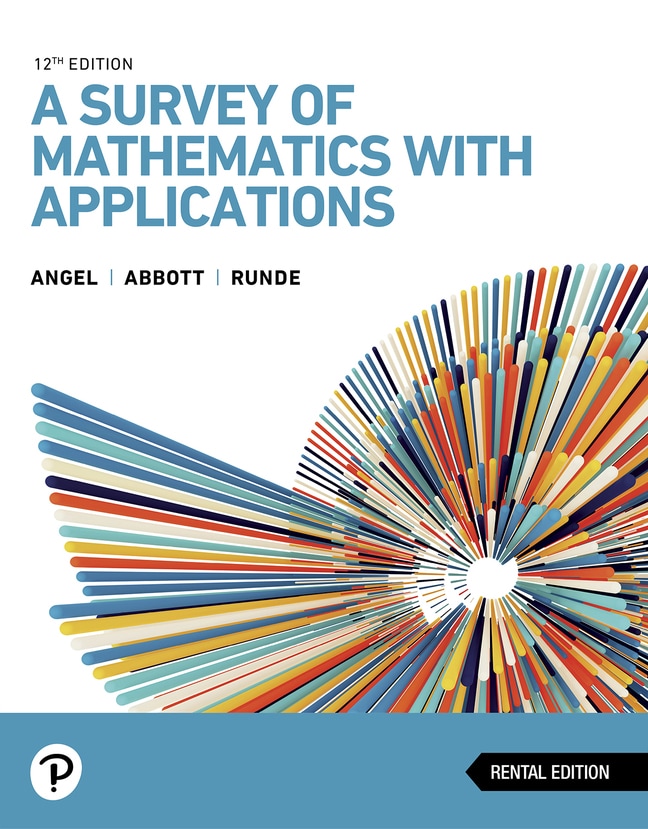
Survey of Mathematics with Applications, A, 12th edition
- Allen R. Angel
- , Christine D. Abbott
- , Dennis Runde

- Find it fast
Quickly navigate your eTextbook with search
- Stay organized
Access all your eTextbooks in one place
- Easily continue access
Keep learning with auto-renew
A Survey of Mathematics with Applications is a text you can actually read, understand and enjoy while learning how math impacts your world (especially for majors in the liberal arts, social sciences, business, nursing, and allied health fields). Real-life applications motivate topics, along with a variety of interesting and useful exercises. It is an ideal text for courses that satisfy the minimum requirement in mathematics for graduation or transfer.
The 12th Edition greatly increases downloadable data sets exercises, expands coverage and exercises in financial literacy, adds new Now Try exercises, and much more.
Published by Pearson (August 20th 2024) - Copyright © 2025
ISBN-13: 9780138306601
Subject: Liberal Arts Math
Category: Liberal Arts Math
Each chapter concludes with Chapter Summary, Chapter Review Exercises, and Chapter Test.
1: Critical Thinking Skills
- 1.1 Inductive and Deductive Reasoning
- 1.2 Estimation Techniques
- 1.3 Problem-Solving Procedures
2: Sets
- 2.1 Set Concepts
- 2.2 Subsets
- 2.3 Venn Diagrams, Set Operations, and Data Representation
- 2.4 Venn Diagrams with Three Sets and Verification of Equality of Sets
- 2.5 Set Applications and Survey Data Analysis
- 2.6 Infinite Sets
3: Logic
- 3.1 Statements and Logical Connectives
- 3.2 Truth Tables for Negation, Conjunction, and Disjunction
- 3.3 Truth Tables for the Conditional and Biconditional
- 3.4 Equivalent Statements
- 3.5 Symbolic Arguments
- 3.6 Euler Diagrams and Syllogistic Arguments
- 3.7 Switching Circuits
4: Systems of Numeration
- 4.1 Additive, Multiplicative, and Ciphered Systems of Numeration
- 4.2 Place-Value or Positional-Value Numeration Systems
- 4.3 Other Bases
- 4.4 Perform Computations in Other Bases
- 4.5 Early Computational Methods
5: Number Theory and the Real Number System
- 5.1 Number Theory
- 5.2 The Integers
- 5.3 The Rational Numbers
- 5.4 The Irrational Numbers
- 5.5 Real Numbers and Their Properties
- 5.6 Rules of Exponents and Scientific Notation
- 5.7 Arithmetic and Geometric Sequences
- 5.8 The Fibonacci Sequence and The Golden Ratio
6: Algebra, Graphs, and Functions
- 6.1 Order of Operations and Solving Linear Equations
- 6.2 Formulas and Modeling
- 6.3 Applications of Algebra
- 6.4 Variation
- 6.5 Solving Linear Inequalities
- 6.6 Graphing Linear Equations
- 6.7 Solving Systems of Linear Equations
- 6.8 Linear Inequalities in Two Variables and Systems of Linear Inequalities
- 6.9 Solving Quadratic Equations by Using Factoring and by Using the Quadratic Formula
- 6.10 Functions and Their Graphs
7: The Metric System
- 7.1 Basic Terms and Conversions Within the Metric System
- 7.2 Length, Area, and Volume
- 7.3 Mass and Temperature
- 7.4 Dimensional Analysis and Conversions to and from the Metric System
8: Geometry
- 8.1 Points, Lines, Planes, and Angles
- 8.2 Polygons
- 8.3 Perimeter and Area
- 8.4 Volume and Surface Area
- 8.5 Transformational Geometry, Symmetry, and Tessellations
- 8.6 Topology
- 8.7 Non-Euclidean Geometry and Fractal Geometry
9: Mathematical Systems
- 9.1 Groups
- 9.2 Finite Mathematical Systems
- 9.3 Modular Arithmetic
- 9.4 Matrices
10: Consumer Mathematics
- 10.1 Percent
- 10.2 Personal Loans and Simple Interest
- 10.3 Compound Interest
- 10.4 Installment Buying
- 10.5 Buying a House with a Mortgage
- 10.6 Ordinary Annuities, Sinking Funds, and Retirement Investments
11: Probability
- 11.1 Empirical and Theoretical Probabilities
- 11.2 Odds
- 11.3 Expected Value (Expectation)
- 11.4 Tree Diagrams
- 11.5 OR and AND Problems
- 11.6 Conditional Probability
- 11.7 The Fundamental Counting Principle and Permutations
- 11.8 Combinations
- 11.9 Solving Probability Problems by Using Combinations
- 11.10 Binomial Probability Formula
12: Statistics
- 12.1 Sampling Techniques and Misuses of Statistics
- 12.2 Frequency Distributions and Statistical Graphs
- 12.3 Measures of Central Tendency and Position
- 12.4 Measures of Dispersion
- 12.5 The Normal Curve
- 12.6 Linear Correlation and Regression
13: Graph Theory
- 13.1 Graphs, Paths, and Circuits
- 13.2 Euler Paths and Euler Circuits
- 13.3 Hamilton Paths and Hamilton Circuits
- 13.4 Trees
14: Voting and Apportionment
- 14.1 Voting Methods
- 14.2 Flaws of the Voting Methods
- 14.3 Apportionment Methods
- 14.4 Flaws of the Apportionment Methods